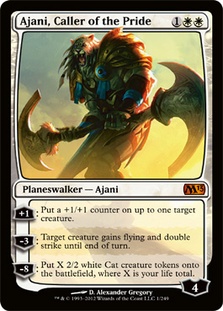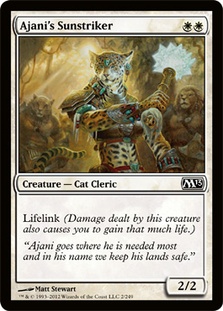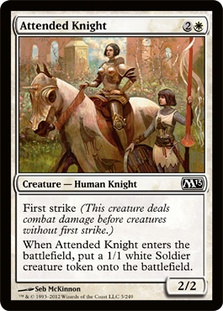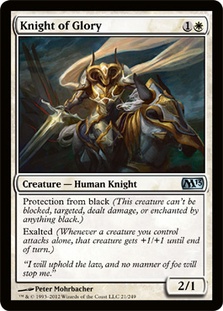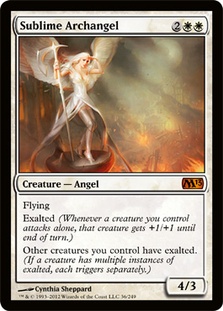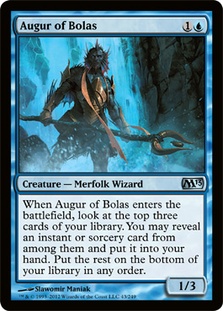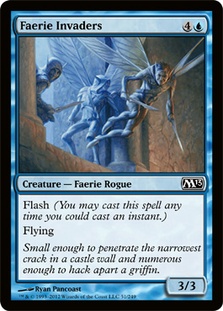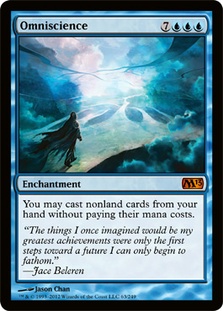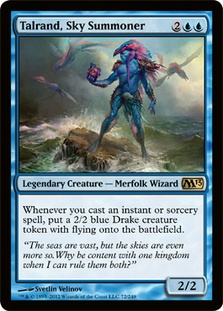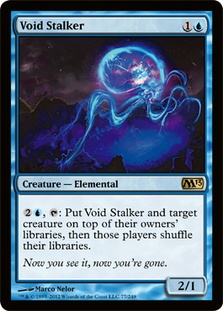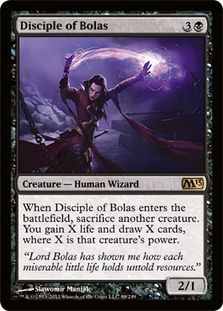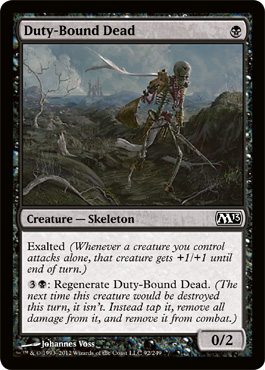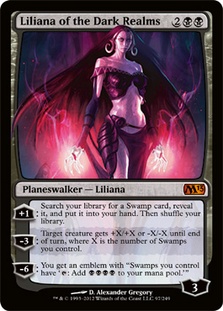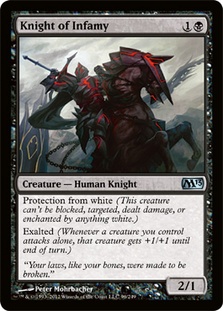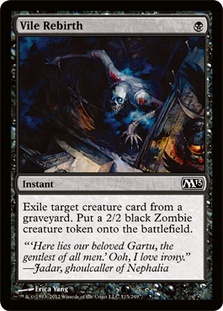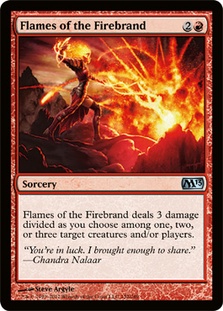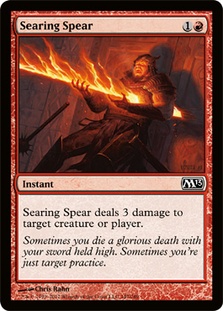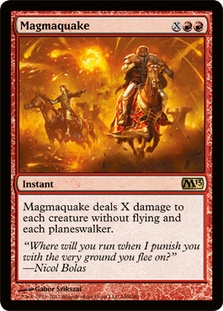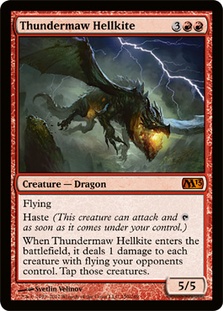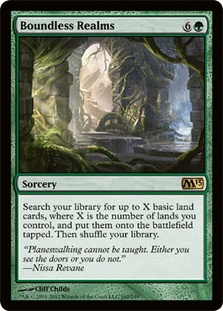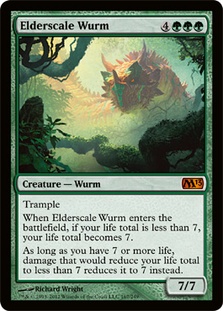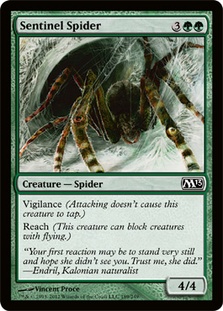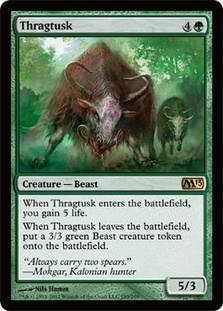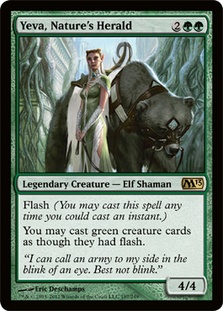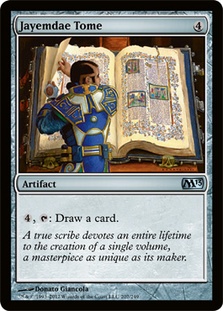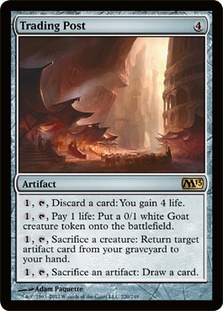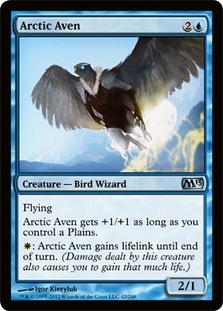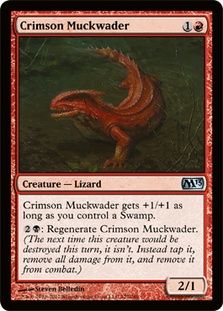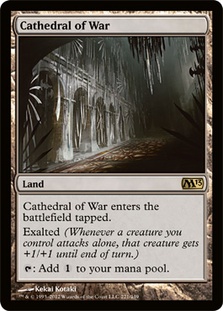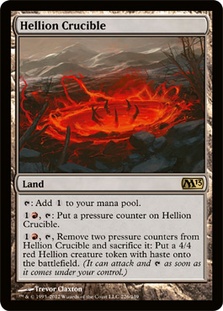Since Magic 2010, base sets have gone from worthless for cube designers to sets where we get more tools to use. The recent core sets have given us a good amount of quality cards for Cube, including the infamous Titan cycle, Baneslayer Angel, Doom Blade, Elite Vanguard, Ember Hauler, and Fauna Shaman. In this article, I’ll be discussing many of the cards from Magic 2013 from a Cube perspective, highlighting the best cards from it and what cards you should consider for your cube.
White
Ajani, Caller of the Pride
As soon as I was texted about what the new Ajani does, I knew that it’d be a good card and decided to test the card when I was cubing at the SCG Invitational in Indianapolis. Unsurprisingly, I found that it definitely was a good card when I got the chance to play with it. Much like Sarkhan Vol, it’s a mostly offensive planeswalker that works very well in aggressive decks through its two powerful abilities that work well with aggressive strategies (unlike Ajani Goldmane, who was mainly used for his extremely powerful -1 ability.)Â
A problem that I saw with it was that unlike mostly offensive planeswalkers like Koth of the Hammer, Ajani doesn’t bring his own threats to the table and it can be awkward on an empty table, but I found that those circumstances didn’t happen that often (and even when they did, Ajani’s high loyalty helped it to survive until you were able to stick a creature on to the battlefield.) Unlike Elspeth, Knight-Errant’s second ability, his ability to throw creatures into the air comes at a high loyalty cost, but it usually doesn’t matter since the game ends quickly after he does his thing. Unless you’re intentionally limiting the number of planeswalkers in your cube, Ajani, Caller of the Pride is an extremely solid Cube card that will be welcomed in white aggro decks.
Ajani’s Sunstriker and Attended Knight (Common)
These cards will be solid additions to pauper cubes with both of them doing imitations of cards in cubes with other rarities—imitators of Knight of Meadowgrain and Blade Splicer, respectively. Attended Knight will be welcome in common/uncommon cubes as an imitation of Master Splicer, but both of these cards will work very well in pauper cubes.
Knight of Glory
When supporting aggro in cube, you use cards that aren’t really flashy but are solid role fillers that get the job done; a good chunk of the two-mana two-power ones are generally ones with a few solid abilities which you can rotate in and out of your cube based on the needs of your cube. When I tested this, I found that it worked very well in aggressive decks. They’re very nice for enabling starts like casting a 2/X on turn 1 and then following it up with the Knight of Glory, letting you attack for three out of the gate, which isn’t difficult because of the 1W cost.
Exalted also actually works surprisingly well in aggressive decks with a lot of evasive creatures like Soltari Monk and Flickerwisp. Creatures with exalted tend to be ranked based on how they’d be with exalted and even without exalted; it being an easy-to-cast 1W for a 2/1 was usually solid and the ease of casting made it perform better than the protection knights of old (Silver Knight, White Knight.) In drafting, I found that it was picked at the rate that I expected—about middle of the pack, and it’s certainly not on the rank of something like Stoneforge Mystic. That said, I think it’s a very solid Cube card and should help to bolster aggressive strategies.
Sublime Archangel
Sublime Archangel is a card that I haven’t seen getting much attention for Cube because of the oft-mentioned insane competition at four mana in white. Unlike something like Odric, Master Tactician, Sublime Archangel definitely has the goods to break through that strong competition. Many people will think of her ability to give exalted to all creatures with regards to tokens strategies and she does perform well there, but she also works extremely well in regular white aggressive strategies and has been a very welcome addition to the white aggressive decks in Cube.
This may seem counterintuitive as those decks usually win with swarm strategies, but those aren’t necessarily conflicting strategies. I saw my friend and podcast cohost Anthony Avitollo draft a very strong B/W aggro tokens deck where a 9/9 Spectral Procession token was chump blocked by a flying Cloudgoat Ranger before ultimately killing the opponent. One of the initial complaints that I’ve heard is that people ask, “If you’re attacking with a bunch of tokens, won’t you be able to just attack with the team and get as much damage?” That doesn’t always happen; sometimes the opponent will have creatures that outmuscle yours and the mass pump helps blow open defenses (my Soltari Priest that blanks the opponent’s red removal is now attacking for six instead of two).
Also, as we’ve learned from creatures like Elesh Norn, Grand Cenobite and Massacre Wurm, a lot of times in the late game there tend to be non-attacking creatures like Viridian Shamans and Stoneforge Mystics that are hanging around doing nothing, and Sublime Archangel turns them into pseudo Akrasan Squires. Even at its worst, Sublime Archangel’s still a four-power flier for 2WW, which, while it isn’t breaking any efficiency barriers (Conundrum Sphinx never made much of an impact, but then again no one plays Shock yet Firebolt and Burst Lightning are Cube staples), still has very solid base stats. I replaced Calciderm with this and as amazing as Calciderm is, Sublime Archangel has been performing better.
Blue
Augur of Bolas
The inevitable truth is that blue is a really tough nut to crack in Cube as the cards tend to do what they do extremely well and the cards that support multiple archetypes (like Standstill performing well in tempo decks and being a decent splash in aggressive decks) do hard work by being very powerful. Augur of Bolas is an interesting card somewhat similar to Delver of Secrets by providing a benefit for playing with a lot of instants and sorceries, a strategy commonly done by blue decks. Augur of Bolas has a powerful ability, but the main question is whether we can take advantage of his ability in Cube. For that, we need to look at the breakdown mathematically.
The math breakdown for hitting with Augur’s trigger is as follows:
10 instant/sorceries:Â 62.35%
11 instant/sorceries: 66.53%
12 instant/sorceries:Â 70.39%
13 instant/sorceries:Â 73.95%
14 instant/sorceries:Â 77.21%
I’ve found that most blue control decks don’t have a hard time getting to at least ten hits for Augur’s trigger since most of the tools in the blue control deck—spot removal, mass removal and even threats through cards like Entreat the Angels and Decree of Justice—are hits for Augur. Recently, I saw a powerful Esper deck that utilized Lingering Souls and other token generators with Opposition along with Augur of Bolas. Much like with Tezzeret, Agent of Bolas, the card selection of the cards that you’d see in Constructed is diminished as both Tezzeret’s and Augur of Bolas’ usually tend to be more of a cantrip than an ability where you get to choose amongst several cards. But both are still great cards that reward you for building around them, which isn’t terribly difficult to do, and thanks to blue’s library manipulation through cards like Brainstorm, Ponder, Jace, the Mind Sculptor and Preordain, I found that getting up hits for Augur of Bolas wasn’t too hard. All in all, a positive surprise.
Faerie Invaders (Common)
Faerie Invaders is a functional reprint of Spire Monitor, a card that’s very good in pauper cubes. Finishers in pauper cubes tend to be on the weaker side with Spire Monitor doing a decent job of being a pseudo Restoration Angel, so it’ll fit right at home in the world of pauper cubes.
Omniscience
This card is interesting since it has a high amount of variance when cast. Typically cards like Debtors’ Knell reward the player by letting you gain a big advantage if you untap with them, but Omniscience gives you the reward if you have any spells in your hand to take advantage of it. The game plan is to cast it when you are able to take advantage of the free spells by having expensive spells and/or a lot of card draw to where you can win shortly after, but the high cost and huge variance will keep it out of many cubes (mine included).
Talrand, Sky Summoner
The best analog to this creature is something like Bloodline Keeper. Unlike in Constructed formats, you won’t have the free Phyrexian mana spells like Gut Shot to take advantage of it. It is interesting because the opponent won’t know if attacking with a 2/2 is safe since your deck may have one, if not more, instants to kill the attacker (especially if you have enough targets to trigger Augur of Bolas), but the overall consistency seems lower and doesn’t crack the tough blue shell. His Invocation which gives four power of flying for 2UU should have a happy home in common/uncommon cubes.
Void Stalker
Oh how I wish this didn’t tap to use! Unfortunately, it requiring tapping puts it in an awkward spot where it can’t act as a five-mana removal spell and generally acts as a weak attacker. It does make me wonder if this would be more welcome in a color like white since white aggressive strategies don’t mind having a 2/1 for 1W (see Knight of Glory), but even the blue tempo strategies don’t welcome it as much. It feels like it is on the cusp of being used in many cubes since, as mentioned earlier, the cards that support blue tempo either are extremely powerful in that archetype or support multiple archetypes, but this doesn’t quite fit either of those categories.
Black
Disciple of Bolas
One of the strange things that I found about Disciple of Bolas was that it had a hard time finding a home in Cube decks as it was generally a late pick (however, that could just be from it being a difficult-to-evaluate card.) It had some interesting uses in aggressive decks that had equipment that could boost the sacrificial fodder (sacrifice my Goblin Ruinblaster with a Grafted Wargear on it, draw five, gain five), and sacrificing a 1/1 is just embarrassing. The best use for it has been in more midrangey black decks that have a lot of creatures with enters-the-battlefield triggers like Nekrataal and Skinrender and others like Abyssal Persecutor and Genesis, as these types of creatures tend to work very well in black midrange strategies and are also great fodder for the Disciple (drawing cards and gaining life both being relevant for that archetype.)Â
It’s also in an awkward situation where it’s competing in Cube with black’s four-drops like Nekrataal and Skinrender; I’ve been trying it in place of Graveborn Muse and haven’t found it to be particularly better or worse than the Zombie Phyrexian Arena, but it’s a nice card to encourage black midrange and aggressive decks with a lot of “boons” (equipment, exalted, etc.)
Duty-Bound Dead (Common)
Duty-Bound Dead looks like it’ll be a solid role-player creature for pauper decks; while its regeneration cost is prohibitively high, it does a lot of nice things that are hard to find in the format. It’s a cheap exalted enabler (only seen in Akrasan Squire in common) and helps push early damage through while defending against other 1/1s.
Liliana of the Dark Realms
I’ve felt that Liliana of the Dark Realms has been a misunderstood card for Cube and when I proxied up Ajani for testing at the SCG Invitational, I decided to test Liliana as well. She’s been surprisingly very good. There are few planeswalkers that kill themselves when using their first minus ability, like Garruk, Primal Hunter and Chandra Nalaar, and since both have ways to defend themselves, the inevitable comparison may be that Liliana 3.0 is bad since a planeswalker’s ability to protect itself has had a strong correlation to its quality (although as we’ve learned, correlation doesn’t imply causation).Â
However, the better analogue is to compare Liliana to other planeswalkers that are card advantage engines like Venser the Sojourner and Jace Beleren who reward you through card advantage if you can find a way to protect them, as playing either on an empty board is usually a bad idea unless you can get a few uses out of the planeswalker. It’s true that she can off herself to destroy an opposing creature, acting like a Limited caliber removal spell like a sorcery speed Chill to the Bone or Murder, but that’s definitely her worst-case scenario and a situation where she usually shouldn’t find herself in since you want to cast her onto a battlefield with some protection. Â
I’ve found that she has been very solid in two-color black decks, as I’ve seen her best used in black decks that have at least five Swamps (although my preferred range is between 6-11) to grab to take advantage of her ability to gain card advantage. She’s been mostly at home in midrange and control decks since they’ve been able to utilize her ability to ensure land drops while thinning out the deck, which has been a surprisingly powerful tool. Much like with Garruk, Primal Hunter, I’ve found that she’s at her best if she can activate her +1 ability and then either act as a removal spell with a bonus (much like Liliana of the Veil) or a continuous card advantage engine according to how the needs of the battlefield dictate. Even if she doesn’t protect herself very well, she has been a very solid addition to my cube.
Knight of Infamy
Much like Knight of Glory, it has been a solid aggressive creature for black decks. Black two-drops aren’t as numerous as they are in white, which has had years of Knights like Knight of Meadowgrain and Knight of the White Orchid, but suffers slightly because there doesn’t tend to be as much evasion in black as there is in white. The lowered competition should make it easier for it to make it into cubes than Knight of Glory, but both should be considered for your cube.
Nefarox, Overlord of Grixis
It’s sad that we’ve come to a day where a 4BB for a virtual 6/6 with evasion isn’t good enough for Cube, but we’ve reached that day since it’s sadly not better than things like Kokusho, the Evening Star, Grave Titan, and Massacre Wurm.
Vile Rebirth (Common)
One of the better graveyard hosers that we’ve seen in some time, it unfortunately is not able to be considered a true one-mana 2/2 because of its inability to be cast on turn 1. Pauper cubes don’t have much in the way of graveyard hosing so Vile Rebirth will be nice to combat the Exhumes and Unearths of the format and unlike cards like Tormod’s Crypt, it’s an answer to graveyard shenanigans that I wouldn’t be embarrassed to run in my maindeck (and it’s also surprisingly good as a pseud-flash 2/2 to fight opposing planeswalkers.) If you feel like your cube needs additional tools against those strategies, Vile Rebirth may be worth a look, but it’s definitely a solid inclusion in pauper and peasant cubes.
Red
Flames of the Firebrand and Searing Spear
Much like with Faerie Invaders, there isn’t too much to see with Flames of the Firebrand and Searing Spear as these both have very close analogues to often-used cube cards (Incinerate and Arc Lightning.) Unless you don’t want to use duplicates or near-duplicates for personal reasons, there is little reason to not use these powerful burn spells.
Magmaquake has an analogue in an obscure card: Fault Line. Even though I use a lot of planeswalkers in my cube and enjoy their interaction with the format, the best-case scenario for Magmaquake hitting multiple planeswalkers doesn’t happen that often. It’s a nice tool to have if you fear planeswalkers being too much a part of your cube, but the already existing X spells like Starstorm (if you don’t want to hit yourself) or the multitude of Earthquakes and single-target X spells like Devil’s Play are much better.
Thundermaw Hellkite
When this was spoiled on the mothership during spoiler week, it was said to be the Dragon analogue of Baneslayer Angel and aside from something like Demigod of Revenge, its combining of haste, evasion, and high power is hard to find. For many years, there wasn’t much competition at five mana in red aside from Siege-Gang Commander, but Thundermaw Hellkite may very well be better than even that and other newcomers like Zealous Conscripts. At worst-case, it’s a flying Lava Axe (that dies to Doom Blade), and usually even that’s just enough to earn many wins as it has done so far in testing. In red-based aggressive decks that only have a single five-drop I’ve been leaning towards Thundermaw Hellkite as my finisher, with the powerful Siege-Gang Commander taking a second seat (although I’d rather have Siege-Gang in more midrange decks.) It was powerful enough to pull someone who almost never drafts red to take it P1P1, draft nearly mono-red, and do extremely well.
Green
Boundless Realms
Unfortunately, this is too expensive for a ramp spell, even if it promises being an analogue to Mirari’s Wake. Seven mana is where spells should seek to quickly end the game and while this may be rocking Commander tables, it won’t be very good in Cube (even in cubes that very heavily support green ramp).
Elderscale Wurm
Alas, Elderscale Wurm is just too weak when compared to other green ramp targets like Avenger of Zendikar, Pelakka Wurm, and Hornet Queen, as those provide much better benefits for midrange and Reanimator than Elderscale Wurm.
Mwonvuli Beast Tracker
The Beast Tracker is a card that, like Stoneforge Mystic was years ago, may be worth another look in a few years once we get some more choice targets for it. The best use for cards like this is to have a toolbox (or an extremely strong silver bullet)—Primeval Titan and Wurmcoil Engine certainly fit the strong silver bullet category, but unfortunately the critical mass of targets needed to get the number of really strong silver bullets or toolbox just isn’t there yet. If green gets access to a few more creatures with the relevant abilities (like Acidic Slime, Vampire Nighthawk, Troll Ascetic, and Abyssal Persecutor) then this card may be Cube-worthy. But today is not that day.
Sentinel Spider (Common)
Five-mana 4/4s have been an odd breed in cube—cards like Barkhide Mauler, Stampeding Rhino, Grizzled Outcast, and Spike Colony being the main members of this cast. Sentinel Spider may very well be the best one, acting as a “ground Serra Angel” without evasion but killing just about anything that it can block.
ThragtuskÂ
Although Thragtusk won’t be able to be used with Birthing Pod as much as it will in the next few months in Standard, Thragtusk is a very solid midrange creature that works very well in creature-based matchups. One small negative is that it may be too slow against aggressive decks that Thragtusk seeks to go against, as the one mana between it and other creatures like Obstinate Baloth and Loxodon Hierarch may be enough to be the difference between life and death. Even when that’s the case, it’s still very solid as one of the best “value creatures” in the format because even if it’s not Naturalizing something like Indrik Stomphowler, the life gain and it getting a 3/3 when the creature leaves the battlefield (clutch against removal spells like Swords to Plowshares, Into the Roil, and other such spells that got around previous protections like persist and undying). Its main home has been in green midrange, and in Reanimator versions of G/B it has been exceptional (especially with cards like Recurring Nightmare or even Animate Dead).Â
Yeva, Nature’s Herald
Like Thragtusk, Yeva fits many midrange strategies like a glove. While it doesn’t make your opponent play Portal-style like Teferi, Mage of Zhalfir, it has performed better than Teferi by being a much more efficient creature. An oft-overlooked feature of creatures with flash is that they tend to act as a form of removal spell; cards like Simian Grunts were used for years back in the day to act as green removal, and Yeva does it with a very efficient body attached (which has usually been good enough on its own even if it “just dies to Doom Blade” or gets finished off with a red burn spell).Â
Untapping with it has been not as useful as I had anticipated, but it has still been useful with green’s many creatures with enters-the-battlefield triggers like Indrik Stomphowler and Woodfall Primus (especially if it’s destroying an opposing Sword or an opponent’s planeswalker that they didn’t use on their first main phase) as well as helping to attack other planeswalkers. Like with Calciderm, Yeva replaced Blastoderm in my cube and while Blastoderm has been extremely good, I have felt that Yeva has been an upgrade (although not as much as Calciderm was to Sublime Archangel.)
Multicolor and Artifacts
Jayemdae Tome
This old-timer is available for the first time at uncommon, making it eligible for use in peasant cubes. It’s a card that can take over games if you can get some draws with it, but its slowness may make it too clunky for that format. Still, you’ve probably got a Ketos’ Zauberbuch hanging around if you’ve been playing for a while!
Trading Post
Trading Post looks to have a lot of flexibility with modes to help keep you alive against aggro, give you chump blockers against control and midrange, ways to recycle dead artifacts, and gives you a way to dump things into the graveyard for Reanimator. Unfortunately it’s just too expensive for that, especially given the activation cost on it. While it does a lot of things, it doesn’t do them very well (much like Obelisk of Alara.)
Flinthoof Boar
The best member of the “Kird” cycle is Flinthoof Boar. Watchwolf doesn’t see play in many cubes because of the competition in G/W, but part of it is the awkwardness of requiring G/W mana on turn 2. The best thing about these creatures (Flinthoof Boar, Arctic Aven, and Crimson Muckwader) is that they don’t require being played with the exact mana to be used; this flexibility is most apparent with Flinthoof Boar since it can act as either a Boggart Ram-Gang (sans Wither) or a Watchwolf in Boar clothing. There have been many times where it has been cast on turn 2 as a 2/2 and then became a 3/3 on attack from a topdecked Mountain; that kind of flexibility isn’t possible with cards like Watchwolf, especially since it can get haste if topdecked on turn 3. This flexibility has been very good and while it isn’t as good as stalwarts like Bloodbraid Elf, Kird Ape, and Huntmaster of the Fells, it’s a very solid fourth in that color pair.
Arctic Aven and Crimson Muckwader
Arctic Aven is a card that I really want to be a more aggressive version of Vampire Nighthawk that trades deathtouch for an additional power and requiring a pump. However, in testing I found that much like how the one-mana activation was a pain on Skinshifter, it was also an annoyance on Arctic Aven, and trying to race with it was harder to do than I had thought. That and, as my friend Anthony Avitollo had pointed out to me, it doesn’t block 2/Xs profitably, making it considerably worse as a blocker. Crimson Muckwader is the weakest out of the cycle that I’d consider for Cube. It’d be mainly used for its three power in an aggressive color combination (ignoring its expensive regeneration cost), but it still won’t find a home in many cubes aside from those with big multicolor sections.
Cathedral of War
I wasn’t too big on Cathedral of War when I first saw it for Cube; it’s been performing better than expected in decks like mono-color and two-color aggressive decks since those decks don’t care as much about the coming into play drawback, nor do they care as much about only making colorless mana. It’s important to realize how powerful abilities are when they’re strapped onto lands since they don’t require a mana cost (after all, we all love a Volrath’s Stronghold but don’t love Haunted Crossroads) and having lands that do something extra, particularly in aggressive decks that can utilize the abilities, is nice as it helps solitary attackers push through extra damage. Unfortunately, the competition is really strong for it—if you classify it as a land or as a colorless card that competes with artifacts and lands that produce colorless/five-color mana, either form of competition will sadly push this out.
Hellion Crucible
Hellion Crucible is a nice way for red decks to utilize free mana, but that usually doesn’t happen in the red-based aggressive decks since they’re using almost all of their mana each turn and typically the virtual three-mana loss is a big hurdle to overcome or at least isn’t as easy to pay as you’d think. I really want this to be the land version of Kargan Dragonlord—a card that, without mana investment, performs a basic function of the deck and then gives you additional use when you put additional resources out of it. Initial testing has shown that the mana cost is indeed a real thing and unlike ones like Barbarian Ring or even Gargoyle Castle, it requires more set up. It may be worth it, but it seems like a worse land than Barbarian Ring or even Ghitu Encampment.
I hope that this article has given you some insight into what Magic 2013 can offer for your cube. Unfortunately, it doesn’t have the impact of Magic 2011 which brought us the Titan cycle, but this set still gives us some nice tools to utilize in our cubes to make them wonderful and diverse environments.
May all of your opening packs contain Sol Rings!
@UsmanTheRad  on Twitter
http://idratherbecubing.wordpress.com – My blog featuring my cube lists and M13 cube update!
The Third Power: A Cube podcast featuring myself and Anthony Avitollo!

